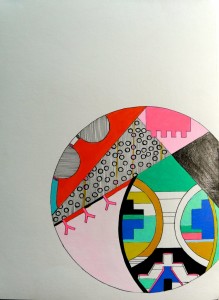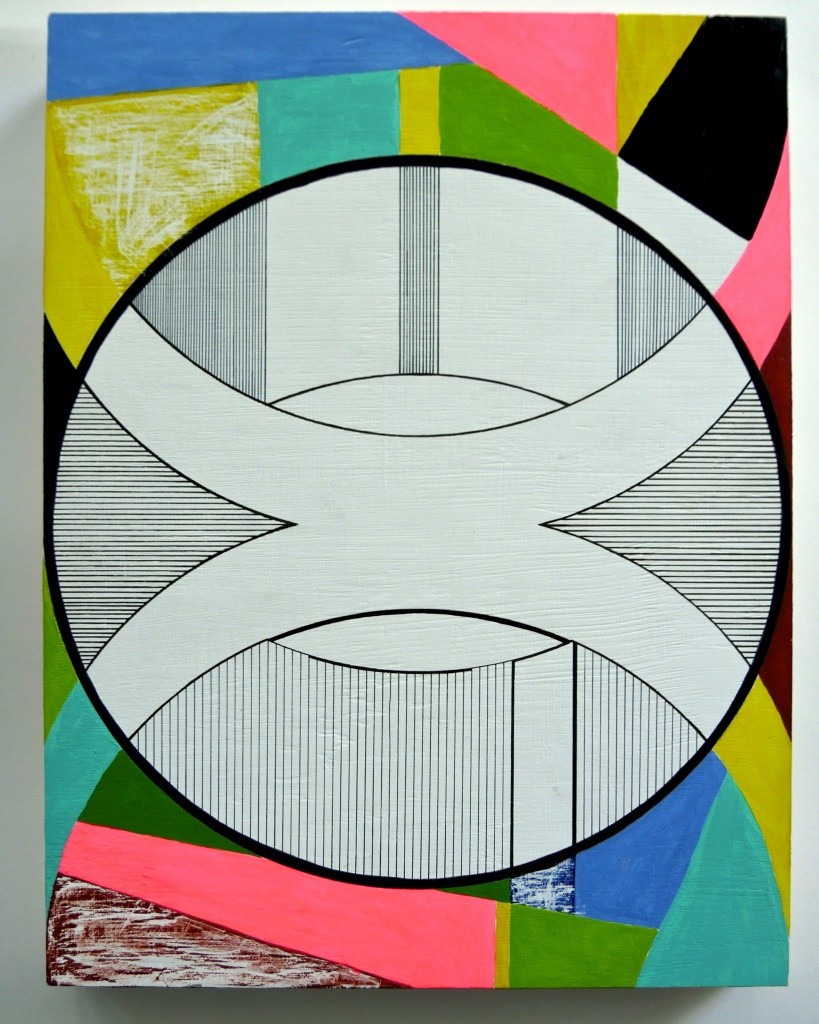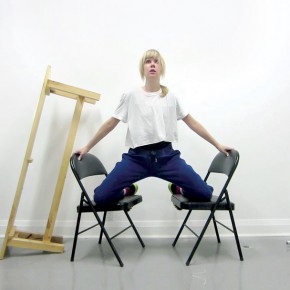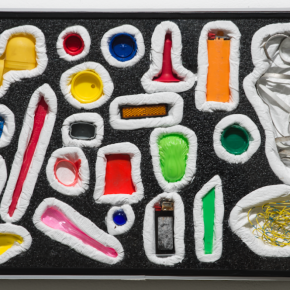Visual Arts News was excited to feature the work of artist Jordan Bennett in our Fall 2015 issue. In this online installation of her interview series, Current Conditions & Forecasts, Eryn Foster chats with Bennett about everything ranging from his experiences representing Newfoundland in Venice to his work bringing traditional Indigenous art forms into contemporary art discourse.
ERYN FOSTER: You were in Venice this summer representing Newfoundland (along with Anne Troake) at the Biennale. How was that experience? What was the response to your installation Ice Fishing?
JORDAN BENNETT: The opportunity to exhibit Ice Fishing at the Venice Biennale was great. It has been very well received throughout the past few months with a large number of visitors interested in both Anne’s work and mine. Venice is an amazing and unique city and being part of such a grand event is something I will not soon forget. It was exciting to see so many viewers come into the exhibition and interact with the installation. The curator of the exhibition, Chris Clark, did an amazing job choosing the works to be part of the show. Anne’s work really gives the viewer a sense of Newfoundland in spring and summer. It’s very poetic in nature. I feel that my work gives a glimpse into the ways of being and existing on the land and water during the long Newfoundland winter months.
EF: Did you feel any stress or pressure in preparing for your show in Venice? Or did you approach the opportunity as you would with any other exhibition?
JB: I approached it with the same mindset as I would have with any other exhibition. The only difference was ensuring the work was securely protected in rugged crates to withstand the long trek. It was truly an honour to be included in the official programming of the Venice Biennale.
EF: You are now in the second year of your MFA at UBC Okanogan. What is it like for you living on the other side of the country? Do you feel that the experience of living out West has influenced the way you make and think about art?
JB: Living in the Okanagan is quite a beautiful experience. Being in a MFA program is definitely a change of speed, as now I am balancing both my ongoing art practice and completing a thesis and exhibition. Being out West has really allowed me to explore new ideas, materials, and methodologies within my practice. [In September] I was at a conference, Performing Turtle Island, in Regina. During his presentation, the academic and actor Michael Greyeyes said, “Being so far from home allows the lenses in your eyes to refocus on it.” This resonated with me, as this is precisely how I feel about being out West.
EF: Can you tell me a little bit about your MFA thesis project? From what I understand, you are looking at the parallels and similarities between the visual cultures of the Beothuk and the Mi’kmaq? What brought you to this research?
JB: Yes that is correct. My thesis work is re-imagining the traditional art forms of the Beothuk and Mi’kmaq into a contemporary art discourse. Through this new work I am making a series of carvings accompanied by sound to create an immersive and interactive environment. My ongoing research came from thinking about the shared history of the traditional people of Newfoundland— the Beothuk and Mi’kmaq—and how centuries of their shared history have been reduced to vague one-liners and inaccurate interpretations, assumptions, and statements by European explorers and settlers on the island. Through creating this new work, I am bringing an Indigenous perspective to the assumptions and myths regarding the historical, physical, and cultural erasure of the Beothuk by European settlers. This is exemplified by the death of Shanawdithit in 1829, who is believed to be the last of her people. In Shanawdithit’s testimony, recorded in the 1827 diary of Bishop Inglis, she recalls that “the Beothuk and Mi’kmaq held relations and had a partial oral understanding of one another for centuries, but in the last 150 years this relationship turned for the worse.” This statement has been one of the factors that has driven me to create artworks rooted in re-imagining a space for both nations to coexist again.
EF: And how has this research informed your creative practice?
JB: Through this research I’ve been employing mediums that I have not explored in a long time such as drawing, painting, and I’ve also been learning wood-carving. Recently, I had the amazing opportunity to visit and learn from fellow artists Dean Hunt, Shawn Hunt, and their father Bradley Hunt of the Heiltsuk Nation. Bradley and his sons are very well known for their mastery in carving amazing cedar panels and totem poles, pushing the limits of both material and visual. I had the honour of spending two weeks with them in their studio, learning techniques of which I am employing in this new body of work. Through researching Beothuk and Mi’kmaq visual culture, I have been creating new drawings based on Porcupine quill designs from the turn of the 19th century along with the drawings of Shanawdithit and Beothuk items and articles found throughout Newfoundland archaeological digs. These new drawings are the basis for my new carvings.
EF: Having grown up in rural Newfoundland, do you feel the landscape and the culture of the island has influenced you as an artist in any particular way?
JB I grew up in the town of Stephenville Crossing on the west coast of the island. I believe that the whole reason I am an artist is based on the landscape and culture of this place. The landscape is both beautiful and brutal, growing up only a rock’s throw from the Atlantic Ocean really makes you appreciate the power of where you come from. My ancestors have lived in this area off the island for countless generations and I think that through a tie like this, you are born with an inherent connection to the land. In our community, as with many other communities in Newfoundland, we still greatly depend on the land for sustenance, be it food or spiritual.
EF: Once you have finished your MFA, do you think you will you move back East? Or do you have some other ideas as to where you might go next?
JB: I would love to move back home. If the opportunity arises, I would be back in a minute, the east coast holds a very special place in my heart. I am also not against going somewhere new that might hold exciting new opportunities.


















Leave a Reply